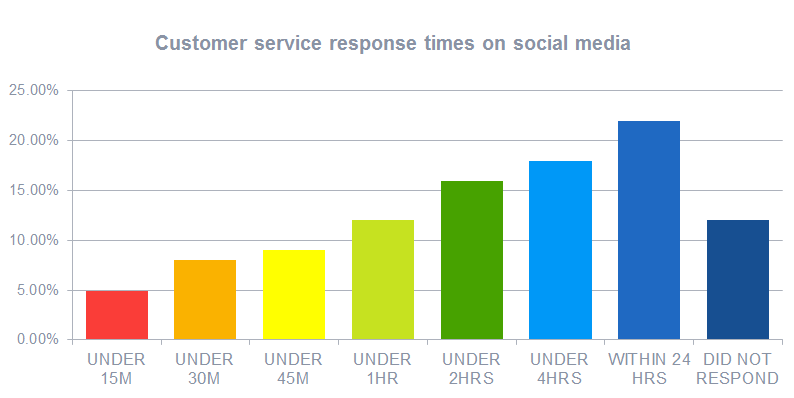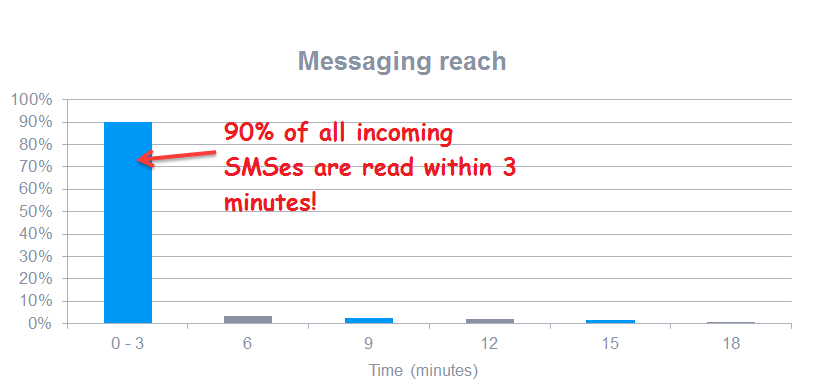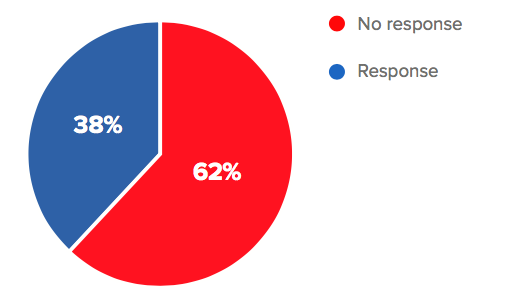* Dữ liệu của bản demo này sẽ được làm mới hai lần / một tháng.
* Nếu bạn muốn có một phiên bản demo cho các gói khác, hãy nhấp vào nút yêu cầu.
Omni-Channel Customer Service Best Practices
Post summary:
- The benefits of consistent service quality
- What is omni-channel customer service?
- Omni-channel customer service best practices
The way that companies handle customer service has changed dramatically in recent years.
More than a decade ago, there were only two ways to contact a company – by phone or by fax (remember fax machines?)
Today, you can take your pick; phone, email, live chat, SMS and social media. The list appears endless.
The challenge for many companies is not only to be accessible in these channels, which is important, but for those channels to deliver consistent and an integrated service quality.
According to Aberdeen Group, companies that provide a consistent service quality across multiple channels retain 89% of their customers, whereas companies that do not provide a consistent quality are only able to retain 33%.
A consistent service quality across multiple channels will significantly impact company revenue.
And this is why more companies are investing in omni-channel customer service!
What is omni-channel customer service?
Omni-channel customer service integrates text, social, email and instant messaging to provide a unified brand experience so that customer can switch between multiple channels yet still experience quality of service.
Omni-channel customer support gives you the opportunity to serve your clients in a variety of ways that are not only convenient and effective, but boost your brand’s image and credibility.
And when you look at stats like Accenture’s finding that 89% of consumersexperience frustration at having to repeat their questions to multiple customer service reps, you see the value in perfecting omni-channel integration.
Omni-channel customer service best practices
In this blog post, we share 7 best practice tips for building an excellent omni-channel service strategy.
Let’s dive right in!
1. People expect good mobile services
It’s no secret that mobile is huge.
More people are searching on mobile and buying on mobile. Therefore, it only makes sense that they’re also seeking customer service support on their mobiles.
Unfortunately, businesses aren’t keeping up with customer expectations of their mobile engagement. 90% of customers say their customer service experience on mobile was negative. And the same study found that 52% of customers say that a poor mobile experience makes them less inclined to do business with a company.
The top complaint of customers searching for customer service on a mobile site is “incorrect display/difficult to navigate”. Slow loading times also frustrate customers looking for information.
 This means businesses that haven’t optimized their websites for mobile use are losing out to companies who have.
This means businesses that haven’t optimized their websites for mobile use are losing out to companies who have.
Bottom line: make sure your customer service and support pages are mobile-friendly.
2. Improve your social media response times
Social media can be a great customer service tool, resulting in high customer satisfaction rates. However, many brands fail to understand customer’s expectations when it comes to providing service through social.
There’s a gap between when customers expect an answer after initiating contact and when businesses are actually responding. 32% of clients want an answer within 30 minutes and 57% of these clients expect the same turnaround on nights and weekends.
But the average response time for leading businesses is 157 minutes. The percentage of businesses who respond within the expected 30 minutes time frame is only 8%. And a full 12% of businesses don’t respond to customer messages on social media at all!

If you ignore social media communications from their clients or fail to prioritize response speed, you can expect increased churn rates of up to 15% due to customer frustration.
According to a survey by NM Incite, slow responses are regarded even more negatively by customers than when a business doesn’t respond at all.
Increasing speed doesn’t only reduce churn; it results in a positive experience for the customer. In one study that looked at airlines responding to clients on Twitter, a response to a tweet that came in under 6 minutes resulted in a client being willing to pay almost $20 more.
Reducing response times on social media and training employees to provide quick and effective solutions can significantly improve your customer relationships.
3. Self-service is the new customer service
More and more customers expect businesses to make it easy for them to solve their customer service issues themselves.
Being able to look up an answer and fix the problem on their own time without having to contact a customer service representative makes it really convenient. In fact, nearly three quarters of consumers prefer to use a business’ website to find a solution vs. other service channels.
There are lots of ways to help customers find solutions with a comprehensive FAQs page being the most widely implemented self-service channel.
Even if customers can’t find the answer themselves and need to contact a representative, the availability of reliable information helps facilitate the customer experience.
This reduces the amount of time it takes the customer service agent to solve the problem and the number of times a customer needs to contact customer service.
The result? Higher customer satisfaction and lower overall costs to the company.
4. SMS works across industries
Texting is a popular customer service platform for many industries. From placing to-go orders with restaurants via text to booking appointments and sending appointment reminders to responding to insurance claims via mobile, SMS is extremely versatile.
Banks have found text messaging to be a perfect channel for sending alerts to clients about possible account fraud. The immediacy of SMS makes it ideal for urgent situations like that.
Likewise, when a client wants to reach out to a customer support agent, 52% of surveyed consumers said they would like to have the ability to do so via text message. While 47% said that texting would improve their overall customer service satisfaction.
In addition, research by Single Point found that 99% of all text messages are read!
If you want to reach your customers, then using SMS is an extremely effective way.

It should also be no surprise that the generation who shuns phone calls and voice-mails (millennials) is also the one that most enthusiastically embraces text as a customer service channel.
5. Live chat can improve sales
Live chat is a very popular form of customer service with 63% of visitors being more likely to revisit a site that offers live chat. And 44% of consumers report that being able to get answers to their questions during a purchase is one of the most important features a website should offer.
The ability to access help quickly and conveniently alleviates customer frustration. In fact, no hold times and convenience were slated as the top two reasons customers prefer live chat in a survey by Software Advice.
Besides being an effective channel for customer service, live chat can improve sales. As customer support agents walk clients through a particular issue, they may be able to identify products or services that would be useful to them.
So not only does live chat benefit your business by reducing bounce rates, it also helps customer service reps upsell to clients.
Professional customer service agents with extensive knowledge of the brand’s products and services can use live chat to provide a positive customer experience and boost sales.
6. Email is still a customer service leader
Don’t discount email just because it’s not a shiny new marketing toy.
Email still works and works very well.
In fact, email wins hand-down as being the most effective digital marketing strategy for customer retention with 56% effectiveness, compared to 37% retention effectiveness with social media marketing and 8% effectiveness from mobile advertising.
Email also gives businesses the opportunity to offer branded messages and is a secure platform that customers trust. 38% of consumers prefer communicating online or via email about simple customer service issues.
Businesses should be aware that the expectation of a fast reply still applies to email. However, as our customer service benchmark report found, 62% of companies do not respond to customer service emails!

Always answer customers when they contact you. If you don’t respond, they are likely to spend their hard earned money elsewhere. And if you cannot answer the question right away, at least inform the customer that you are working on it, and let them know when they can expect a reply.
7. Try it yourself
An incredible number of businesses that spend time and money building omni-channel service fail to perform the last step – test it out.
Oftentimes, the customer service software you use to create your omni-channel experience will let you know which areas are performing well and which areas need some improvement.
This gives you an essential overall picture. But, there’s nothing like initiating a live chat or posting a tweet and waiting to see the speed and quality of the response to discover if things are running smoothly or not.
Conclusion
Omni-channel customer service is the solution for forward-thinking businesses.
However, don’t forget the human touch that ties it all together. And well-trained staff that can address customer concerns and deliver a positive image of your brand is the key ingredient to providing top-notch customer service.
And remember – no matter which channels you choose to use in customer service, the priority is, and always will be, to provide a helpful and honest experience that will continue to grow your relationship with your customers.
What lessons have you learned from implementing omni-channel customer service?
Let us know below by leaving a quick comment.
Giữ thông tin
Giới thiệu
Công cụ câu hỏi
Số liệu thống kê
| Yêu cầu: 03:03, 28/09/2018 |
| Xem: 3424 lần |
| Cập nhật: 03:03, 28/09/2018 |




